We deal with a triple SIM mobile phone for the first time. Let us introduce you the Explay B240. As the majority of dual-SIM handsets this phone is also cheap because its target customers are the people who want to save money on mobile operator services.
The retail package of the Explay B240 is standard issue stuff. In the box (Pic. 1), as well as the phone itself, you’ll find headphones, a data cable and a 1-port USB wall charger (Pic. 2). So you can charge this handset through USB data cable. In addition there is another charger jack, the same as that of the Nokia.
The design of the phone is as basic as it gets (Pic. 3, 4). The thin casing doesn’t weigh much. Under the back cover lies a 1000 mAh Li-ion battery. The phone is equipped with a camera and a polyphonic speaker which produces quite a loud sound.
As usual, we tested the two Explay B240 handsets.
Results
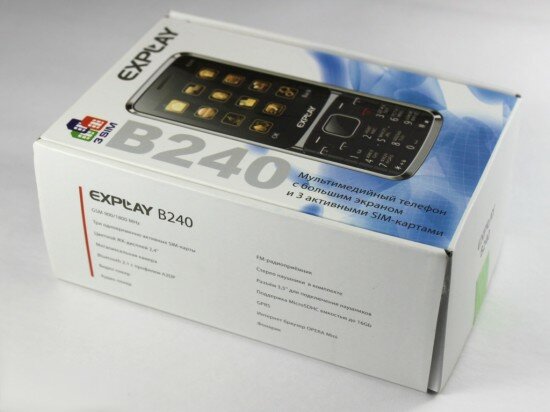
Pic. 1. Package box
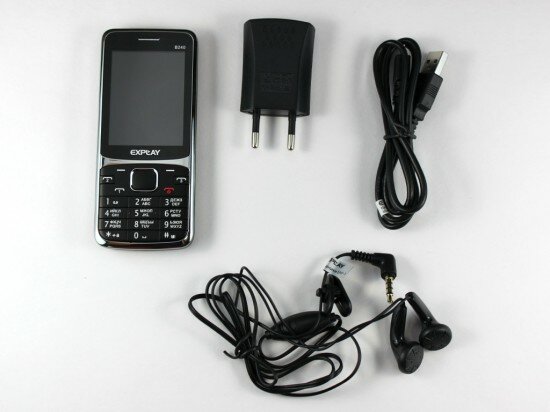
Pic. 2. Accessories
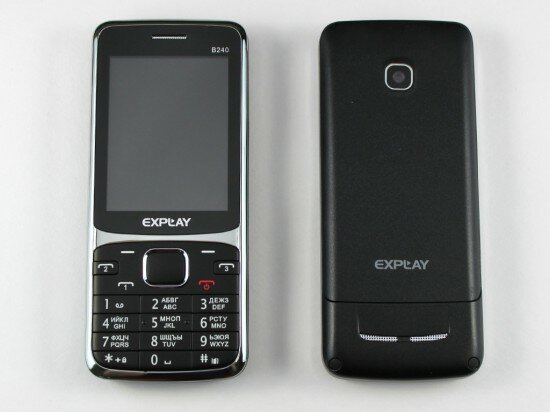
Pic. 3. The Explay B240 from the front and from the back
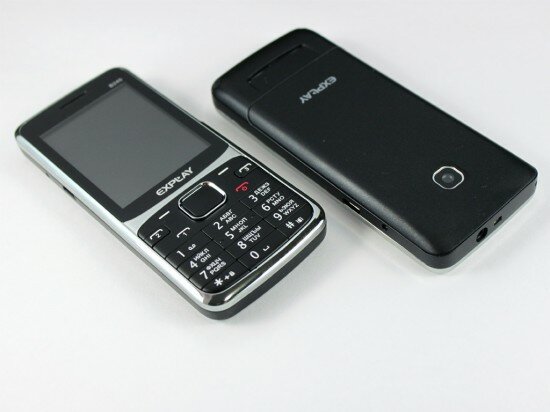
Pic. 4. Middle edge of the Explay B240
The Explay B240’s stress tests (the 1st handset)
1. Reception quality test
The first test of any our review is on signal strength of the phone. We used a plain cardboard box, applied glue all over it and pasted aluminum foil rectangles over all the surfaces of the box. Then we cut a 45 mm by 50 mm slot (1.57-inch by 1.97-inch) into the top of the lid and put the Explay B240 inside the box through this slot. The smaller dimensions of the slot, the weaker the signal of the phone.
We started calling to the phone. The reception stayed quite strong and the handset received all incoming calls. But we made the slot smaller: 20 mm by 20 mm (0.787-inch by 0.787-inch) and started calling to the phone again. The result: all the incoming calls were successfully received. At last we made it 15 mm by 15 mm (0.59-inch by 0.59-inch) and the signal reception fell only by 2 points (the signal indicator consists of 6 bars). Anyway, the Explay B240 received all incoming calls (video 1 – 3).
Video 1. Reception quality test (stage 1)
Video 2. Reception quality test (stage 2)
Video 3. Reception quality test (stage 3)
Grade (stage 1): 3 (with 3 being the highest possible grade)
Grade (stage 2): 3 (with 3 being the highest possible grade)
Grade (stage 3): 3 (with 3 being the highest possible grade)
2. Freeze test
In order to check the performance of the Explay B240 in extremely cold weather, we placed it in a freezer for 2 hours in speaking mode and for 30 minutes in standby mode. The temperature was -15 °С (5 °F).
We should say that in freezing temperatures, cell phone batteries deplete quicker than usual (that is, their capacity goes down much faster compared to moderate temperatures). By the way, the screen and the keypad malfunction very often in cold weather.
After the test we examined the phone (video 4). The picture on the screen was fine. The keys became a little bit stiff but worked with no problem. The battery didn’t deplete more than by half. But there was something wrong with the vibration. It became much louder. The sound restored when we dried and warmed the phone.
Video 4. Here’s how the phone looks like after the freeze test.
Grade: 3 (with 3 being the highest possible grade)
3. Short circuit of the battery charger
In this test we found out how the Explay B240’s battery charger can withstand a short circuit. We just connected the terminals for a second (video 5).
The wall charger survived and stayed absolutely functional.
Video 5. Short circuit of the battery charger
Grade: 3 (with 3 being the highest possible grade)
4. Short circuit of the battery
We tested the battery the same way. Connected the terminals (“+” and “-“) of the charger for a second (video 6). Every cell phone battery has a circuit that protects it from short circuits. That’s why the battery stayed functional and didn’t even deplete.
Video 6. Short circuit of the battery
Grade: 3 (with 3 being the highest possible grade)
5. Charging the phone with extremely high and low voltage
In this test we checked the phone’s reaction to different rates of charging. You risk to damage your mobile phone if you charge it with inappropriate charger or with a damaged charger. We used a regulated power supply that was plugged into the outlet. One end of the charger cable was plugged into the regulated power supply. The other end of the cable was plugged into the charger jack of the phone. So we were able to control the rate of charging, increase or decrease it as we wished
Next, we slowly turned the charging rate up to 8 V (the normal rate is 5 V). The phone showed perfect results. It performed fine and the current consumption was OK (video 7).
Video 7. Charging the phone at a higher rate
Grade: 3 (with 3 being the highest possible grade)
6. Providing the phone with extremely high power
We provided the phone with extremely high power, much greater than a standard battery can provide. This test helps to assess the quality of the phone’s electric circuits and reveals how the handset stands up to extremely high power. Such things can rarely happen to your mobile phone in real life unless you use another power source instead of the battery.
We lifted the battery out of its compartment and connected the regulated power supply into the phone directly. Then we slowly increased the power rate from 4 V to 7 V (video 8). But had we reached 6 V, the phone started to malfunction: the display went off and the current consumption jumped sharply. We had to decrease the power to the normal rate and reboot the handset. Fortunately, it stayed functional and performed with no problem.
Video 8. Providing the phone with extremely high power
Grade: 2 (with 3 being the highest possible grade)
7. Leaving the cell phone out in the rain
All electronic devices are “afraid” of water. Mobile phones can be damaged by water much more often than other gadgets. Rain and wet hands are “bitter enemies” of your phone. We shouldn’t also forget about freezing temperature that can be the reason of a steam condensate.
So we prepared some water tests for the Explay B240. At first, we simulated a situation when a person leaves his/her cell phone out in the rain. We put the handset under low-flow shower for 1 minute (video 9).
The device stayed functional during the whole experiment and 1 minute after it. But then it switched itself off. We decided to examine the handset and took off the back cover and saw many drops of water inside the casing (Pic. 5). The exposed connectors were also wet (Pic. 6). We shook the Explay B240 in order to get rid of all the water. But it caused a more serious problem: some water penetrated under the screen glass (Pic. 7). It took us an hour to dry out the phone till it started to perform fine again.
We had to lower the grade for the phone in this test because it switched itself off.
Video 9. Leaving the cell phone out in the rain
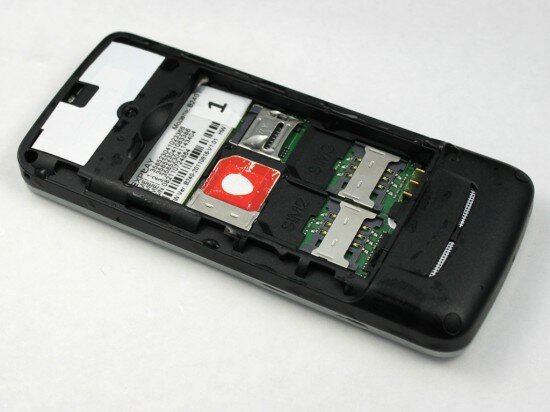
Pic. 5. Water in the battery compartment
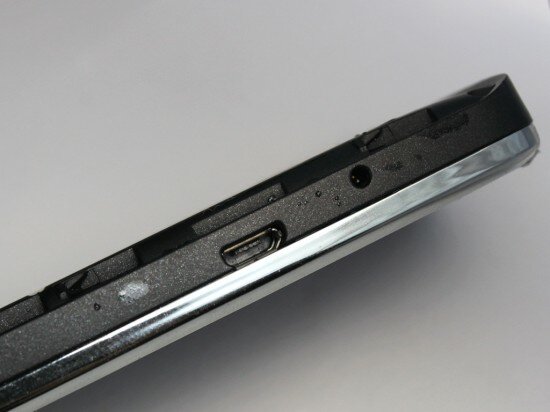
Pic. 6. The exposed connectors
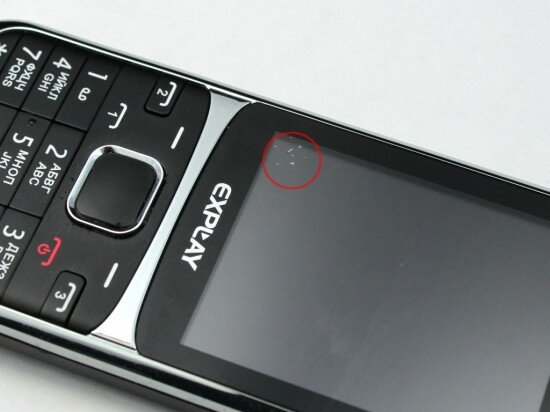
Pic. 7. Drops of water under the screen glass
Grade: 2 (with 3 being the highest possible grade)
8. The Explay B240’s submerge to a shallow depth
This time we dunked the handset under water for 20 seconds (video 10). But the results were better than in the previous test. The phone stayed functional. We made and received calls with no problem. The battery didn’t get very wet. We saw almost no water in its compartment.
We dried the phone after the test and it performed pretty fine.
Video 10. The Explay B240’s submerge
Grade: 3 (with 3 being the highest possible grade)
9. The Explay B240’s submerge to a depth of one meter (3.28 feet) for 20 seconds
In this experiment we dropped the handset in a long pipe filled with water (to a depth of one meter (3.28 feet)) and kept it there for 20 seconds.
To our surprise the Explay B240 didn’t switch itself off as the majority of the other mobile phones. But it didn’t receive incoming calls (video 11).
After the test, we tried to reboot the Explay by means of lifting out its battery. But the phone refused to turn on. Water penetrated everywhere: in the connectors, under the battery and the screen glass.
Then we dried the handset for almost a whole day and at last we turned it on. By the way, the phone performed pretty fine. The only thing we didn’t like were the spots of water on the display.
Video 11. The Explay B240’s submerge to a depth of 100 cm (3.28 feet)
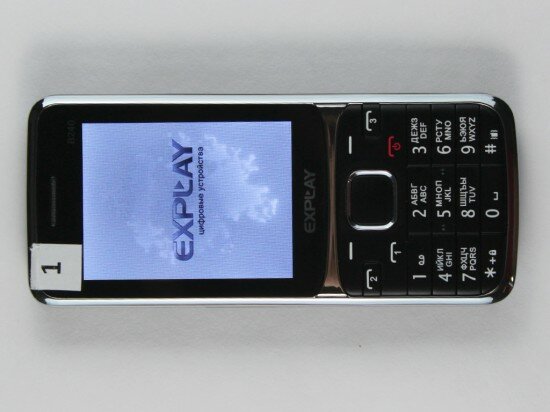
Pic. 8. Spots of water on the display
Grade: 2 (with 3 being the highest possible grade)
10. Submerge to a depth of one meter for 30 minutes
Only IPx1-IPx6 waterproof cell phones are eligible for this test.
Grade: –
11. Submerge to a depth of two meters
Only IPx7 waterproof cell phones are eligible for this test.
Grade: –
12. Immersion in beer
This is the last test in this “group”. We dunked the Explay B240 under beer and kept it there for 10 seconds (video 12).
Beer is a much better conductor than water. It penetrated the ear-microphone jack and the charger jack and caused a short circuit. The phone identified the headphones. The microphone and the loudspeaker didn’t work. So we couldn’t use the phone. Though this experiment was shorter than the previous one, the beer penetrated much deeper inside the casing than water. We also saw many drops of beer in the battery compartment.
After careful examination we washed the phone a little bit and dried it out. It worked pretty fine afterwards.
Video 12. Immersion in beer
Grade: 2 (with 3 being the highest possible grade)
13. Disassembling. Build quality
The first Explay B240 handset passed all the stress tests that we had prepared for it. Now it’s time to disassemble the phone and examine its build quality and innards. However, we found serious disadvantages even before. Some area of the circuit board is located close to the SIM card compartment. So you may accidentally damage the elements of the board with your finger if you try remove the SIM card.
When we took this phone apart we understood why it belongs to a budget class. All the elements are non-removable. Everything is soldered to the circuit board: the display, the loudspeaker, the vibration motor, the camera (Pic. 10, 11). The steel shield is also soldered to the board. All of this makes the Explay B240 cheap and difficult to repair.
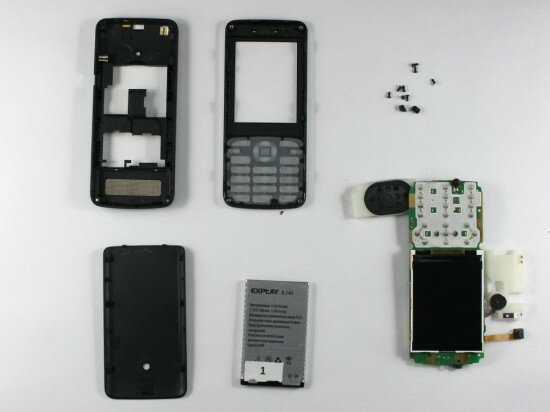
Pic. 9. The phone disassembled
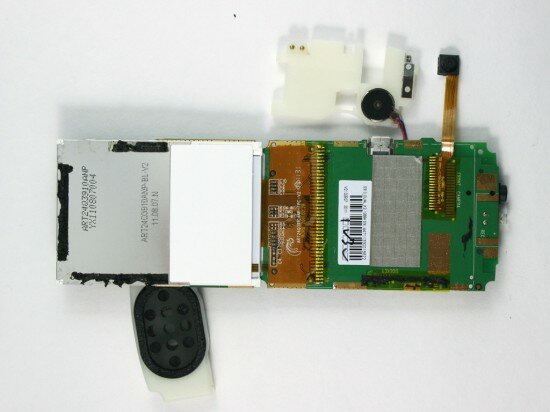
Pic. 10. The front side of the circuit board

Pic. 11. The other side of the circuit board
Grade: 2 (with 3 being the highest possible grade)
14. Headphone cable testing (bending)
Perhaps, everyone had his/her headphones short out. It seems that your headphones work fine but suddenly you understand that one of the earbuds has no sound? This is a very common problem which is caused by a break in the wire.
In order to check reliability of the Explay B240’s headphones, we bended the wire with the help of a machine, devised specially for this experiment (video 13). The whole test was divided into 3 stages: 1000, 1500 and 2000 bends. We examined the state of the headphones after every stage and fortunately they stayed functional afterwards.
Video 13. Bending the headphone cable
Grade (stage 1): 3 (with 3 being the highest possible grade)
Grade (stage 2): 3 (with 3 being the highest possible grade)
Grade (stage 3): 3 (with 3 being the highest possible grade)
15. Headphone cable testing (static loads)
This is another stress test for the headphones. We pulled the cable like a string and hung the three loads on it like people hang their clothes on the clothesline (video 14). Every load weighed 1 kg (2.2 lbs).
The result: no break in the wire, no shorts. Everything worked fine.
Video 14. Headphone cable testing (static loads)
Grade (stage 1): 3 (with 3 being the highest possible grade)
Grade (stage 2): 3 (with 3 being the highest possible grade)
Grade (stage 3): 3 (with 3 being the highest possible grade)
The Explay B240’s stress tests (the 2nd handset)
1. Cell phone’s reception
At last, another Explay B240 came to our hands. We started with the same test and checked the phone’s reception. We examined the new phone the same way as the previous one. We used the same box and the same lids with different slot dimensions.
The results were also the same. The signal was quite strong even with the smallest dimensions of the slot. The phone received all incoming calls.
Grade (stage 1): 3 (with 3 being the highest possible grade)
Grade (stage 2): 3 (with 3 being the highest possible grade)
Grade (stage 3): 3 (with 3 being the highest possible grade)
2. Talk time
The Explay B240’s battery capacity is not very great. Actually, 1000 mAh is too little for a triple SIM mobile phone. The manufacturer’s website informs that the talk time is very short (only 6 hours). But we decided to check it.
At first, we charged the battery. Next, we made a call to the phone, received it and left the phone in speaking mode. We had to dial every hour again and again because mobile operators disconnect subscribers after every hour of talk.
Based on the results of the test, we can say that the manufacture underestimated their product because its talk time is 16 hours and a half. It doesn’t matter how many SIM cards you have in your handset because when you talk through one SIM card, the other two are switched off.
Grade: 3 (with 3 being the highest possible grade)
3. Drops on the carpet
The fastest way to damage a mobile phone is to drop it on the floor. We dropped the Explay B240 on different types of flooring. At first, the handset fell on the carpet with each face, edge and corner from 100 cm (3.28 ft), 150 cm (4.9 ft) and 200 cm (6.56 ft). This test was divided into three stages according to the height of drops. Check out the videos (15 – 17).
The result: the device sustained no damage and stayed functional.
Video 15. Drops on the carpet from 100 cm (3.28 ft)
Video 16. Drops on the carpet from 150 cm (4.9 ft)
Video 17. Drops on the carpet from 200 cm (6.56 ft)
Grade (stage 1): 3 (with 3 being the highest possible grade)
Grade (stage 2): 3 (with 3 being the highest possible grade)
Grade (stage 3): 3 (with 3 being the highest possible grade)
4. Drops on a tile
We made the drop test much tougher. The phone fell on a tile the same way as on the carpet. But the heights were shorter: 30 cm (11.8 inches), 50 cm (1.64 ft) and 100 cm (3.28 ft). This test was also divided into three stages according to the height of drops. Check out the videos (18 – 20).
The result: the device sustained no visible damage and stayed functional. The back cover didn’t even fell off.
Video 18. Drops on the tile from 30 cm (11.8 inches)
Video 19. Drops on the tile from 50 cm (1.64 ft)
Video 20. Drops on the tile from 100 cm (3.28 ft)
Grade (stage 1): 3 (with 3 being the highest possible grade)
Grade (stage 2): 3 (with 3 being the highest possible grade)
Grade (stage 3): 2 (with 3 being the highest possible grade)
5. Crushing the phone with a wooden bar
You may damage your cell phone if you accidentally sit or step on it. Such things do happen in real life. So we tried to simulate such a situation.
The conditions of the experiment: we put the Explay B240 on a smooth surface (e.g., a table) and placed a wooden bar on top of it. Then we applied some pressure above the bar. At first we applied 5 kg (11 lbs), then 20 kg (44 lbs) and 50 kg (110 lbs) (Pic. 12).
Both panels of the handset are flat. This shape helped it to pass the test with no problem. We saw no signs of deformation or any other visible damage on the casing and on the battery.

Pic. 12. Crushing the phone with a wooden bar
Grade (stage 1): 3 (with 3 being the highest possible grade)
Grade (stage 2): 3 (with 3 being the highest possible grade)
Grade (stage 3): 3 (with 3 being the highest possible grade)
6. Breaking the cell phone in half (bending)
The effect of the bend test is similar to crushing. But in this case the pressure doesn’t spread all over the casing. It is concentrated at a particular point of the phone. This is common in real life (e.g., everyone can sit down on a chair with a phone in a back pants pocket).
Actually, we put the Explay B240 onto the two planks so that each edge of the handset lay on a single plank. Then we hitched a string with a load on top of the device. At first 3 kg (6.6 lbs) (Pic. 13), then 7 kgs (15.4 lbs), and finally: 15 kgs (33 lbs).
Even when we used a 3 kg load the bend was clear. It became much more evident we increased the weight. The phone was bended greatly when the mass of the load was 15 kgs. However, the handset stayed absolutely functional. We had only to adjust the back cover which was a little bit shifted.
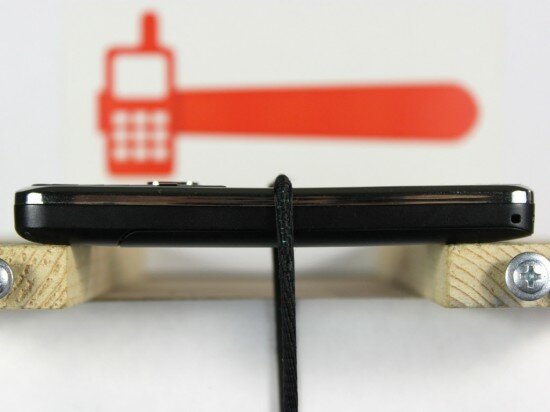
Pic. 13. Bend caused by the 3 kg load (6.6 lbs)
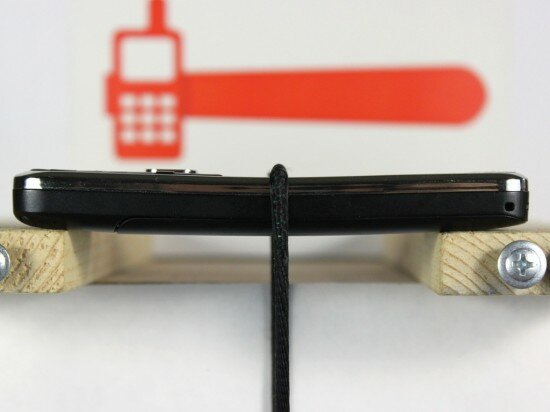
Pic. 14. Bend caused by the 7 kg load (15.4 lbs)
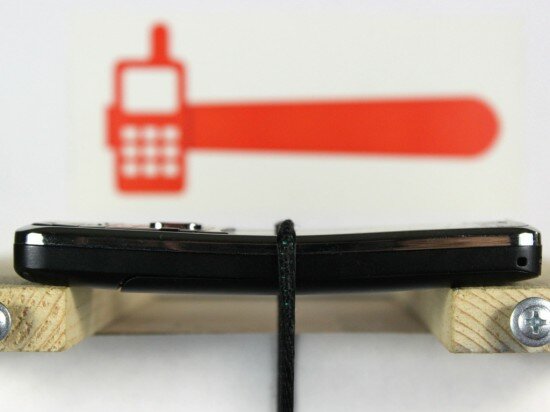
Pic. 15. Bend caused by the 15 kg load (33 lbs)
Grade (stage 1): 3 (with 3 being the highest possible grade)
Grade (stage 2): 3 (with 3 being the highest possible grade)
Grade (stage 3): 3 (with 3 being the highest possible grade)
7. Keyboard
The keyboard is nothing to boast of. But it’s not very bad also. Although the keys are big, you are likely to press the wrong one because the key travel is always the same and it doesn’t give you a positive tactile feedback. The keys don’t have much of a “feel”, by the way.
The keyboard is made of a low quality plastic. The bottom layer is not stuck properly to the circuit board. We’ll provide you with more detailed information about the Explay B240’s keyboard during the following stress tests and in disassembling chapter. But now we can give it only 1 point.
Grade: 1 (with 3 being the highest possible grade)
8. Dust and sand
It’s terrible to see dust piled up under your mobile phone screen. It ruins picture on the screen and makes the handset look unattractive. If you have dust in your phone it means that it’s not dust resistant. But if dust penetrates under the bottom layer of the keypad you’ll definitely have to repair it.
In this test we threw the phone inside an enclosed tray containing dust and made it vibrate viciously for some time. The whole test was divided into periods: 1, 3 and 6 minutes (video 21). We checked the state of the handset after every period of the experiment.
In one minute we examined the phone for the first time. There were a few grains of dust under the back cover (Pic. 16). The connectors were also dirty, though we could easily clean all of them (Pic. 17). However, it was impossible to get rid of the dust that piled up under the screen (Pic. 18).
After the second period of vibration in the tray, more dust penetrated under the Explay B240’s screen (Pic. 19).
After the third period of this test, we saw much more sand and dust inside the casing, compared to the previous times (Pic. 20). As for the screen, there was a huge pile of dust under it (Pic. 21). The picture was clear, though. Then we found out that some of the keys didn’t work any more (video 22). It was impossible to repair the phone simply by cleaning it. We had to disassemble the Explay. However, we decided not to take action and go further with what we have.
Video 21. Dust test
Video 22. Keypad damage
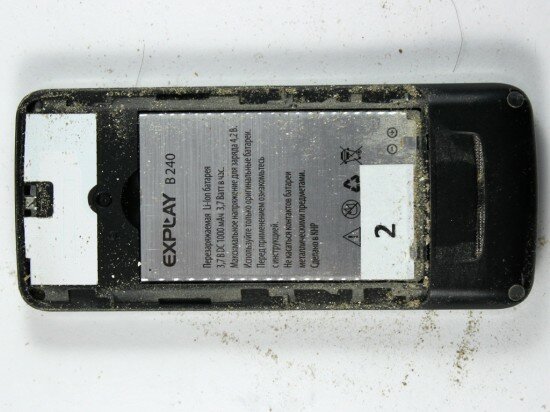
Pic. 16. Dust under the back cover (the 1st period)

Pic. 17. This is how the connectors look after the 1st period of the test
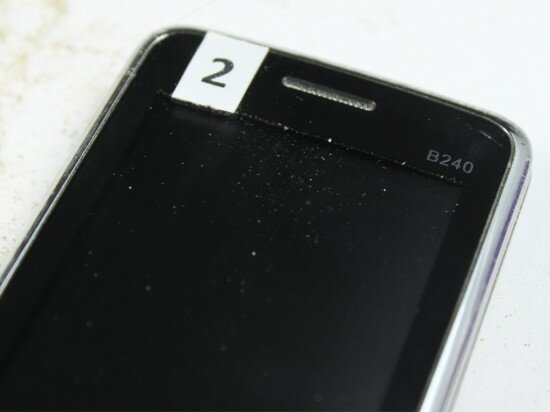
Pic. 18. Dust piled up under the screen (the 1st period)
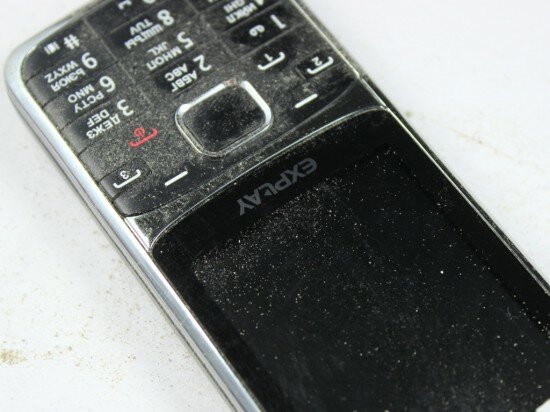
Pic. 19. Dust piled up under the screen (the 2nd period of the test)
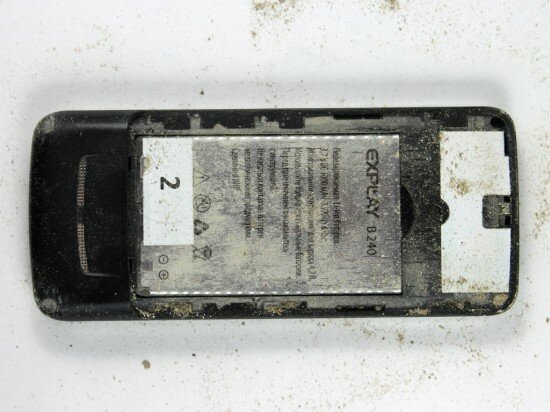
Pic. 20. Dust and sand under the back cover (the 3rd period of the test)
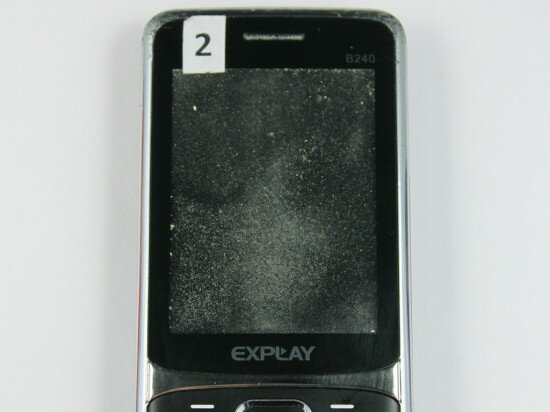
Pic. 21. Dust and sand piled up under the screen (the 3rd period of the test)
Grade (stage 1): 2 (with 3 being the highest possible grade)
Grade (stage 2): 2 (with 3 being the highest possible grade)
Grade (stage 3): 1 (with 3 being the highest possible grade)
9. Durability test
We placed the Explay B240 in a tray with its face down. Then we made this tray vibrate. Thus we tried to use the friction force in order to scuff the phone (video 23). This test was also divided into three periods: 5, 10 and 15 minutes.
As a result, we didn’t see any visible damage.
Video 23. Durability test
Grade (stage 1): 3 (with 3 being the highest possible grade)
Grade (stage 2): 3 (with 3 being the highest possible grade)
Grade (stage 3): 3 (with 3 being the highest possible grade)
10. Simulation of carrying the phone in a pocket
In order to find out how the Explay B240 will look like after a few months of use and even abuse we performed the following test. We placed the handset inside a drum together with keys, pennies, and plastic balls to simulate what might be happening in a man’s pants pockets while carrying the phone (video 24) because the majority of people tend to keep their handsets there. The drum was rotated for 5 minutes at the speed of 500 rpm making the phone, the keys, the pennies and the balls strike against each other. After the test, we examined the handset.
The chrome-effect band around the casing is the most vulnerable part of the phone. The paint on the corners was scuffed completely. (Pic. 22).
Next, we rotated the drum with the phone and all the above mentioned things for 10 minutes. As a result, some big scratches appeared on the back cover (Pic. 23). Moreover, we saw the 2 small cracks on the screen (Pic. 24). There is no wonder because the screen glass is so thin that you can even touch the display if you press the screen with your finger.
Finally, we rotated the drum for 15 minutes. As a result, all the area on the corners framed by the band was completely scuffed (Pic. 25). The screen glass sustained lots of scuffs too (Pic. 26).
Video 24. Simulation of carrying the phone in a pocket
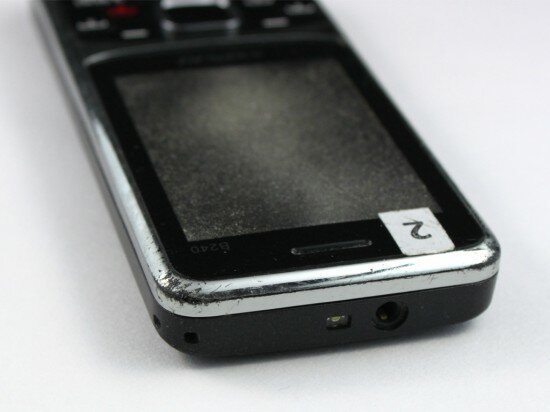
Pic. 22. Scuffs on the chrome-effect band after the 1st rotation

Pic. 23. Damage of the back cover after the 2nd rotation

Pic. 24. Cracks on the screen after the 2nd rotation
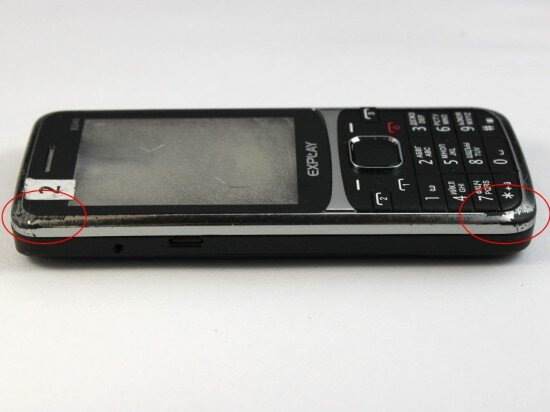
Pic. 25. This is how the corners of the phone look like after the 3rd stage of the test
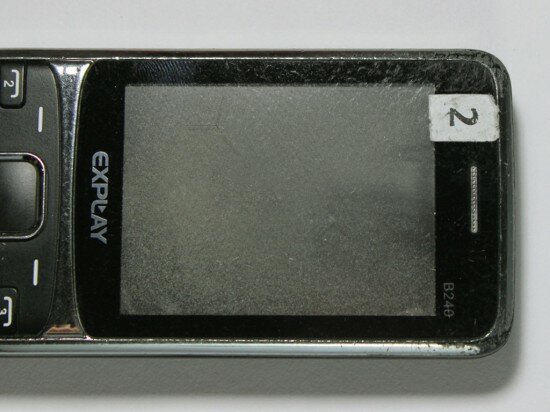
Pic. 26. Scuffs on the screen after the 3rd stage of the test
Grade (stage 1): 2 (with 3 being the highest possible grade)
Grade (stage 2): 2 (with 3 being the highest possible grade)
Grade (stage 3): 2 (with 3 being the highest possible grade)
11. Scratch resistance of the screen
From the previous test you know that the Explay B240 has a low quality screen glass. This time we checked its scratch resistance with the help of a plank with a nail in it. We put the handset on a table and applied 100 g pressure (0.22 lbs) above the plank so that the tip of the nail pressed against the phone’s screen. Then we moved the phone as if we were going to take it from under the nail. Thus we made the nail run over the screen (video 25). We hoped to see a scratch in the result. But there was nothing because this pressure is too little to cause a visible damage.
Next, we tried to scratch the screen again. But this time we applied 300 g pressure (0.66 lbs). So we got a visible scratch on the screen. But it wasn’t enough for us and we went further. Finally, we applied 600 g pressure (1.3 lbs) and got a deep and large scratch. In fact, the Explay B240 showed the same results as the majority of the other cheap mobile phones.
Video 25. Screen scratching
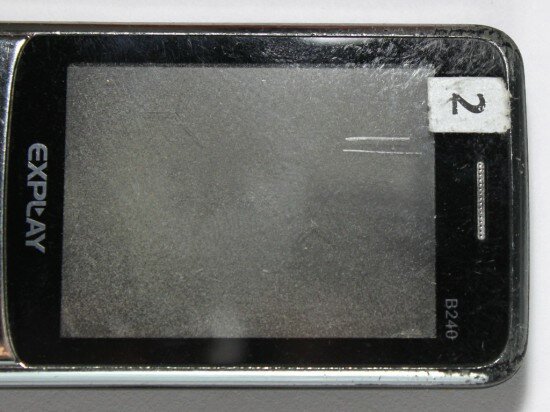
Pic. 27. Scratches on the screen
Grade (100 g pressure): 3 (with 3 being the highest possible grade)
Grade (300 g pressure): 2 (with 3 being the highest possible grade)
Grade (600 g pressure): 2 (with 3 being the highest possible grade)
12. Scratch resistance of the back panel
Actually, we scratched the back cover the same way as the screen (video 26). The force of pressure was the same too. We can infer that the phone is not scratch resistant. Generally speaking, it’s not worse and not better than the others. As a result, we got two visible scratches on the back cover (Pic. 28).
Video 26. Back panel scratching (the pressure is 100 g (0.22 lbs))
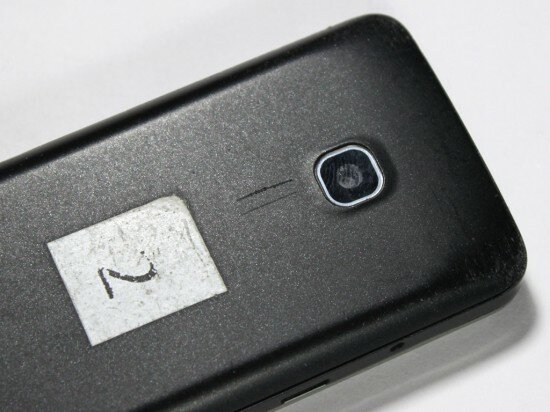
Pic. 28. Scratches on the back panel
Grade (stage 1): 3 (with 3 being the highest possible grade)
Grade (stage 2): 2 (with 3 being the highest possible grade)
Grade (stage 3): 2 (with 3 being the highest possible grade)
13. Screen glass crack
The screen already sustained two tiny cracks inflicted by the strikes against the keys, the plastic balls and the coins. But now we are going to break the screen by dropping a steel ball on it. The diameter of the ball is 22 mm (0.86 inches).
We dropped the ball on the screen for 3 times: from 10 cm (3.9 inches), 15 cm (5.9 inches) and 25 cm (9.8 inches) (video 27). We were really disappointed because the screen stayed safe. There were no visible cracks besides the old ones.
Video 27. Screen glass crack
Grade (stage 1): 3 (with 3 being the highest possible grade)
Grade (stage 2): 3 (with 3 being the highest possible grade)
Grade (stage 3): 3 (with 3 being the highest possible grade)
14. Heat test
In this test we simulated the influence of sun rays and proximity to a fire source. The Explay B240 was placed in a small can together with the light bulb (40 Wt). Then we turned on the bulb and it heated the phone for 3 minutes. After that we took it out and examined the handset. There was no damage. The phone wasn’t very hot. Next, we heated the Explay the same way but for 5 minutes. Soon we felt a smell of burnt plastic. We took the phone out of the can and noticed that the keypad melted. The temperature of the handset wasn’t very high, though (100 °С or 212 °F). Anyway, the keypad stayed functional (those keys that weren’t damage during the dust test).
Finally, we heated the phone for 10 minutes and the keypad melted much more (Pic. 29). By the way, the screen glass melted a little bit too (video 28 – 30).
Video 28. Heating for 3 minutes
Video 29. Heating for 5 minutes
Video 30. Heating for 10 minutes
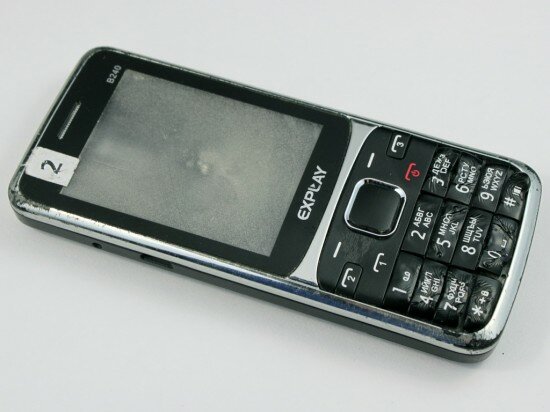
Pic.29. This is how the keypad melted
Grade (heating for 3 minutes): 3 (with 3 being the highest possible grade)
Grade (heating for 5 minutes): 2 (with 3 being the highest possible grade)
Grade (heating for 10 minutes): 2 (with 3 being the highest possible grade)
15. Smashing the phone
The Explay B240 survived all the drops on the tile from short heights. So it seemed ruggedized to some extent. But in this test we increased the height of drops to 150 cm (4.9 ft). As a result, the back cover fell off (at least something happened). However, the handset wasn’t so lucky when we dropped it on the tile from 200 cm (6.56 ft). The screen malfunctioned greatly and the phone switched itself off several times. We couldn’t always turn it on at first attempt. Sometimes the keypad didn’t work at all. The polyphonic speaker didn’t function properly. We can only infer that there were some problems with the circuit board.
At last, we dropped the Explay B240 from 240 cm (7.87 ft) and the camera lens fell off. But it was nothing in comparison to general state of the phone. It switched itself off and we couldn’t turn it on any more.
Video 31. Drops on the tile from 150 cm (4.9 ft)
Video 32. Drops on the tile from 200 cm (6.56 ft)
Video 33. Drops on the tile from 240 cm (7.87 ft)
Grade (150 cm (4.9 ft)): 3 (with 3 being the highest possible grade)
Grade (200 cm (6.56 ft)): 1 (with 3 being the highest possible grade)
Grade (240 cm (7.87 ft)): 0 (with 3 being the highest possible grade)
16. Disassembling. Build quality
After all the stress tests, the second Explay B240 handset came to our mobile phone mortuary where it was disassembled and all the innards were carefully examined. There were some strong reasons for disassembling. First of all we should answer why the keypad and the polyphonic speaker were damaged, and why the phone stopped working in general.
As for the keypad, everything was clear. Check out picture 30. Dust and sand piled up under the bottom layer because this layer wasn’t properly attached to the circuit board. Conducting shreds along the sides of the bottom layer allowed all the grains of dust penetrate inside.
As for the loudspeaker, the voice coil was torn during the drops and the sound was damaged. To tell you the truth, we couldn’t find the reason why the phone refused to switch on. But we think that there were serious problems with the processor assembly. It may happen to any mobile phone if you drop it very often.
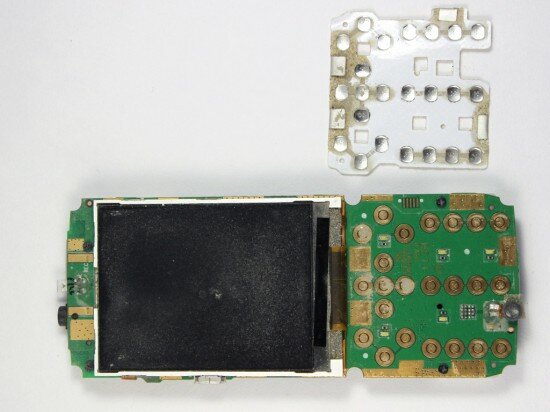
Pic. 30. Dust under the bottom layer
Grade: 2 (with 3 being the highest possible grade)
All in all, the Explay B240 gains 591 point (with 702 being the highest possible grade)
Final words
The Explay B240 showed very poor results in our stress tests. Its dust resistance leaves much to be desired. For the first time in our life we saw such a huge pile of dust under the screen. Water also penetrated the phone with no problem.
Another disadvantage of the handset is its disability to survive heat. The fragile plastic keys melted greatly, though the temperature of the phone wasn’t very high.
As for durability, chrome effect band is a weak point of all cheap cell phones. The Explay B240 is not an exception.
The handset showed fine results in drop tests on the tile till we increased the height to 240 cm (7.87 ft). Soon the phone became absolutely useless.
As a result, the state of one phone is OK (it stayed functional and didn’t sustain serious damage). The state of the other phone is very poor. It doesn’t work and looks awful.
To compare the appearance of both cell phones, check out video 34 and pictures 31 – 34.
Video 34. Here’s how both handsets look like after all the stress tests
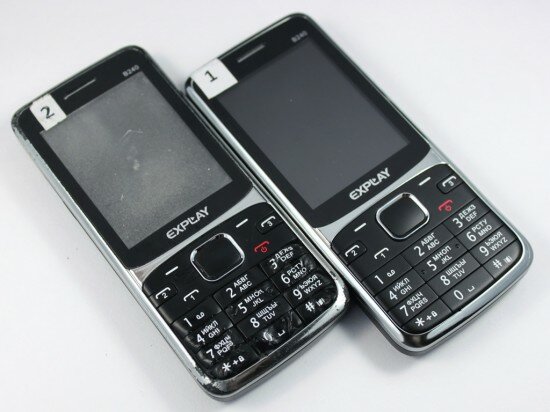
Pic. 31. The front
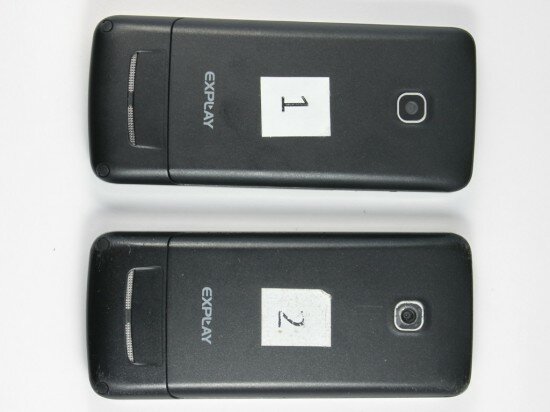
Pic. 32. The back
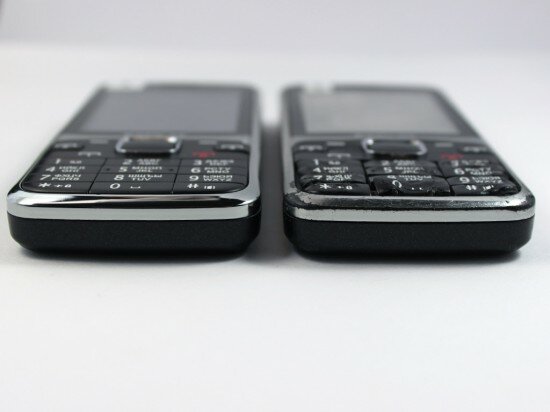
Pic. 33. The middle edges
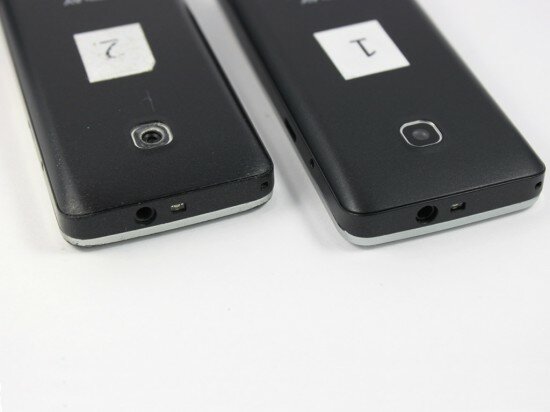
Pic. 34. The back cover and the middle edges

 Russian version
Russian version